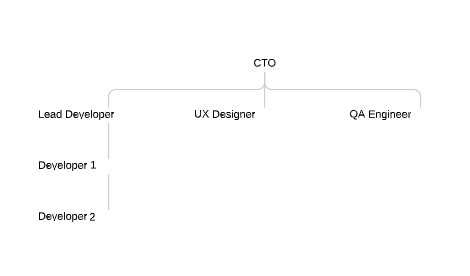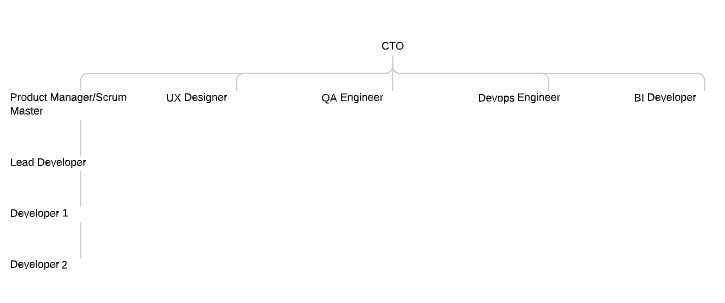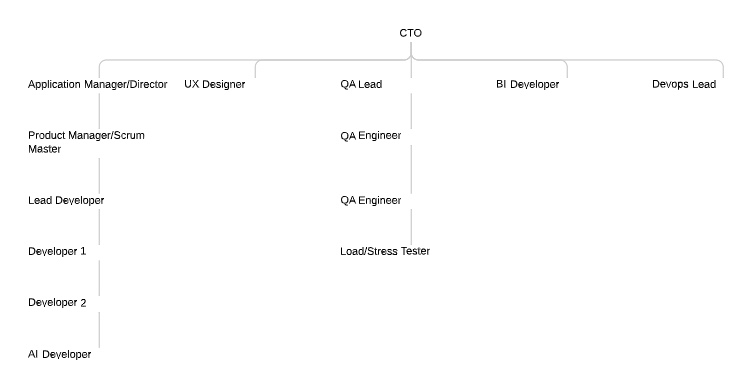A CTO’s role may vary based on the product stage and company size. This article talks about how the CTO’s role evolves as the company’s IT infrastructure and resources grow.
Stages of Software
Stage
# IT Members
Description
MVP
1-5
Initial Minimum viable product. Often an Alpha or Beta release of the project.
Product-Market Fit
1-10
At this point an MVP has been launched and the team is focused on bug fixes and feature enhancements to gain traction.
Adoption
10-20
At this point the MVP has evolved with a viable set of features and has a user base. A regular release schedule is defined and enhancements are regularly released.
Scaling
20-50
At this point the system users are regularly engaged with the platform and new users are regularly added.
Enterprise
+50
At this point, the software is a viable software product with a full IT team infrastructure supporting it.
MVP Stage Company
At the MVP stage of the software the CTO acts in several capacities including product owner, project manager, development manager and software architect. They ensure the platform meets the needs of the business and they align different solutions for integration. They may work with partners to implement integrations and are the face of the IT organization.
The CTO may be coding on the solution but the optimal team has the coding done by full-time developers. Learn more about best practices when hiring a dev team.
Problems at this Stage
The problems the CTO is solving at this point are focused on:
- Product Development
- Hiring a Team
- Quality
- MVP Release
Typical Org Chart - MVP

Product Market Fit Stage Company
At this stage, the CTO acts as a firefighter in addition to the other roles at the MVP stage. They have to balance the development team’s efforts between planned enhancements, end user feedback and bugs.
Additionally, they are leading the efforts to implement tools and solutions relative to best-practices including:
- Error logging: Reviewing unhandled errors in the system
- System outage monitoring: Processes that verify server uptime requirements
- On call support: Rotation of on call calendar between team members if system outages occur
- Operational reporting: Initial reporting for KPIs, uptime, errors
Problems at this Stage
The problems the CTO is solving at this point are focused on:
- Bug Fixes
- Handling User-Reported Issues
- Major Features for User Adoption
- Product Pivoting
- Reporting and Devops
- Standardizing Processes Across Teams
Typical Org Chart - Product Market Fit

At this point the IT team structure looks similar to the MVP stage, but the CTO may need more leadership assistance to meet the business demands.
Sometimes a development manager may be hired to fill the product manager/scrum master role.
Adoption Stage Company
At this point if the software is successfully adopted and usage is continuing to grow, the CTO needs to expand the team to support the continued growth of the applications. They need to balance scalability requirements (do the current servers support the user growth and when will the system start to experience issues), product roadmaps, IT partnerships, and vendor management. Project and Product Managers are brought on to manage product requirements and project execution. A scrum master might be brought on instead of a project manager to facilitate the release management process.
They are leading the efforts related to:
- Scalability Tests including Load Testing (when does system performance suffer)/Stress Testing (when does the system fail)
- Devops – automating deployments and ensuring hardware scales based on usage
- BI – creating dashboards and KPIs to support business operations
- Help Desk – implementing tools and processes to optimize end user support
- Project Management – when to expect the next round of defects and enhancements
- Product Roadmaps – when should platforms and integrations be developed based on the evolution of the software and investment required to support
Problems at this Stage
The problems the CTO is solving at this point are focused on:
- Bug Fixes
- Hiring Management Team Members
- Product Management
- BI
- Devops
- Scalability Testing
- More Process Definition and Refinement
Typical Org Chart Structure - Adoption

Scaling Stage Company
At this point, the software is established and has a core group of users and is continuing to grow in both user base and complexity. At this time, the CTO is less involved in the day-to-day firefighting and more focused on managing execution across multiple teams. Management positions are created to handle day-to-day issues and manage product roadmaps for their respective teams. Managers are hired for specific teams once the team size starts to exceed 7-10 people.
Software teams are more formal around their buy vs. Build strategies (when to buy software packages and configure it vs. Building custom systems to support the business.)
They are leading the related to:
- Release Management: having predictable, well-communicated releases with release notes and training
- Portfolio Management: how to prioritize and allocate IT resources across multiple projects and teams
- Traceability/Audits: ensuring any future auditing or compliance tasks are able to be supported
- Customer Support: Ensuring end users have systems and processes to track support tickets and support SLAs
- KPIs: Ensuring SLAs are met between software services and support services
- Budgets: Ensuring a run rate/growth rate for IT budgets is defined (Run Rate is the “break/fix” minimum IT spend for a company, Growth Rate is based on budgeting for projects planned for the year.)
Problems at this Stage
The problems the CTO is solving at this point are focused on:
- Portfolio Management
- Release Management
- Building Leadership Teams
- IT KPI/SLA Tracking
- Budgeting
- Hiring IT Leadership
- Culture
Typical Org Chart Structure - Scaling Stage

Enterprise Level Company
At this point, the software supports a viable business that continues to grow in both complexity and features across many software products and platforms.
Departments are finely tuned and each department has separation of duties. Projects require a PMO to manage the execution of tasks between teams. Auditing requirements and security requirements increase as the company has more liability and risk related to their data and end user experience.
The CTO is responsible for ensuring that the teams perform across multiple levels of discipline across different IT frameworks and best practices such as ITIL, SOC, HIPAA, Agile, Project Management, Product Management, Analytics, Security, Research and Development, and Disaster Recovery.
Problems at this Stage
The problems the CTO is solving at this point are focused on:
- Audits/Compliance
- Security
- Portfolio Management
- Budgeting
- Hiring Executive IT Leadership
- Culture and Employee Retention
Typical Org Chart Structure - Scaling Stage

TLDR
A CTO’s Role and the IT team structure changes as the company evolves from startup to enterprise. The CTO must transform from a hands-on technician to a strategic leader within the organization.
Startup: The CTO manages product, architecture, and individual team members.
Product-Market Fit: The CTO continues to manage the product, architecture and team members. Additional project management support may be brought in at this point.
Adoption: The CTO brings in key managers for product execution and brings in expertise across to support operational support (Devops, BI, Customer Success)
Scaling: The CTO starts to build management teams for product execution and begins to mature the IT processes across teams.
Enterprise: The CTO leads a team of executives responsible for individual IT groups (Development, Infrastructure, Customer Success, Integration, Architecture, BI, PMO, Helpdesk) and most projects require organizational alignment for success.



